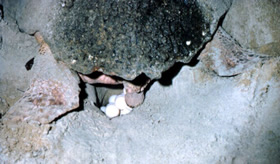Nesting Disturbance Study
 Eleven loggerhead turtles were intercepted
on the nesting beach prior to oviposition and equipped with radio
transmitters. These turtles were intercepted a total of 65 times
following initial instrumentation. Each time, the turtle was prevented
from nesting, usually by just standing in front of her. The responses
of the turtles were 1) relocate their nesting site 2) emerge more
frequently, and 3) attempt nesting in unsuitable habitat. For several
turtles this resulted in almost continuous attempts to emerge and
nest during the fourth, fifth, or sixth night after instrumentation.
While the frequency of emergences increased and the time and distance
from emergence to attempted digging was reduced, the amount of disturbance
required to cause an aborted emergence did not change dramatically.
Activities on the beach which result in prolonged nesting intervals
can result in nest site relocation and placement of nests in unsuitable
areas.
Eleven loggerhead turtles were intercepted
on the nesting beach prior to oviposition and equipped with radio
transmitters. These turtles were intercepted a total of 65 times
following initial instrumentation. Each time, the turtle was prevented
from nesting, usually by just standing in front of her. The responses
of the turtles were 1) relocate their nesting site 2) emerge more
frequently, and 3) attempt nesting in unsuitable habitat. For several
turtles this resulted in almost continuous attempts to emerge and
nest during the fourth, fifth, or sixth night after instrumentation.
While the frequency of emergences increased and the time and distance
from emergence to attempted digging was reduced, the amount of disturbance
required to cause an aborted emergence did not change dramatically.
Activities on the beach which result in prolonged nesting intervals
can result in nest site relocation and placement of nests in unsuitable
areas.



